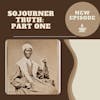Sojourner Truth: Part One

Happy 2022!
I wanted to start the year off by sharing the story of a strong woman from history. Born a slave in New York in 1797, Sojourner Truth lived what seems like ten lifetimes. From self emancipation to suing to rectify wrongs, Truth was a woman strong in her convictions and dedicated to her faith.
So this week I am starting the life and times of Sojourner Truth.
SOURCES:
Anti-slavery bugle. [volume] (New-Lisbon, Ohio), 21 June 1851. Chronicling America: Historic American Newspapers. Lib. of Congress. (LINK)
Biography.com Editors. “Sojourner Truth Biography.” Biography.com. January 6, 2021. (LINK)
“Compare the Two Speeches.” The Sojourner Truth Project. (LINK)
Folsom, Burton W. “Black History Month: The Crusade of Sojourner Truth.” Mackinac Center for Public Policy. February 1, 1999. (LINK)
History.com Editors. “Sojourner Truth.” History. May 25, 2021. (LINK)
Michals, Debra. “Sojourner Truth.” National Women's History Museum. National Women’s History Museum, 2015. (LINK)
Painter, Nell Irvin. Sojourner Truth: A Life, A Symbol. New York: W.W. Norton & Company, 1996.
Pope-Levison, P. “Sojourner Truth, Nee: Isabella Baumfree. (ca. 1791-1883) – Abolitionist, women’s rights activist and itinerant evangelical. Social welfare History Project. (LINK)
“Sojourner Truth: Ain’t I A Woman?” National Park Service. Women’s Rights National Historical Park. Updated November 17, 2017. (LINK)
The Narrative of Sojourner Truth. Dictated by Sojourner Truth (ca.1797-1883); edited by Olive Gilbert; Appendix by Theodore D. Weld. Boston: The Author, 1850. (LINK)
Truth, Sojourner. “Address to the First Annual Meeting of the American Equal Rights Association.” New York City, May 9, 1867. Edited by Heidi Jacobs. (LINK)
Support the show (http://www.buymeacoffee.com/civicscoffeepod)
“I feel that if I have to answer for the deeds done in my body just as much as man, I have a right to have as much as a man. There is a great stir about colored men getting their rights, but not a word about the colored women; and if colored men get their rights, and not colored women theirs, you see the colored men will be masters over the women, and it will be just as bad as it was before.” Sojourner Truth May 9, 1867.
Welcome to Civics and Coffee. My name is Alycia and I am a self-professed history nerd. Each week, I am going to chat about a topic on U.S history and give you both the highlights and occasionally break down some of the complexities in history; and share stories you may not remember learning in high school. All in the time it takes to enjoy a cup of coffee.
INTRO MUSIC
Welcome back peeps! Happy New Year! How in the heck is it 2022?
This year, I wanted to start out with a story of a strong woman from history. In reviewing the timeline, someone kept creeping up as the perfect candidate. Born in 1797, Sojourner Truth lived a life filled with historical events - from Civil War to the abolition of slavery to the increased demand for the franchise for women - Sojourner Truth witnessed - and participated in the struggle for - many of the country’s earliest and most prolonged fights when it came to living the credo it was built upon.
She is most famous for a speech given in 1851 at the Ohio Woman’s Suffrage Convention, however much of Truth’s life as we know it today is what has been shared through the eyes of others. A woman who never learned how to read and write, Truth did not leave behind journals or letters to friends and family. As a result, her story is diluted through the interpretations of those on the outside looking in.
What is known about Truth is through her captured sermons. A woman committed to her mission and talented enough to earn support along the way, Sojourner Truth preached her way into becoming a symbol for many. Given the breadth of her experiences and the events she lived through, this will be a two parter.
So who was Sojourner Truth? What did she do? And why is her story important?
Grab your cup of coffee, peeps. Lets do this.
Sojourner Truth, whose birth name was Isabella, was born around 1797 in Roundout Creek in New York. Born into slavery, there were no official records documenting her birth. Unlike many owners in the south, those who claimed ownership of Truth did not maintain detailed records of the births and deaths of their human property. Her parents, James and Elizabeth, were also slaves and Isabella was the youngest of anywhere between ten and twelve children. Isabella did not become Sojourner Truth until 1843 when Truth went through a rebirth of sorts during her religious conversion. However, since most know her as Sojourner Truth, I will refer to her as such throughout the episode.
The trauma of slavery impacted Truth’s family early and often. Her parents had to suffer through the horrors of seeing their children sold off one by one to neighboring farms. As a child, Isabella only had a chance to meet one brother, Peter, before she was herself sold several times including in 1810 to a man by the name of John Dumont. As anyone whose studied its history knows, slavery was filled with indignities and abuses, large and small. While living with the Dumonts, Truth suffered both sexual and physical abuse; mainly at the hands of the lady of the house, Sally Dumont.
In 1815, she married another slave Thomas and over the span of nine years, had five children: Diana, Peter, Elizabeth, Sophia and an unknown fifth child. By 1826 as the last child, Sophia, arrived, New York was preparing to eliminate slavery within its borders, providing for a statewide emanicipation in 1827. Under the state law, anyone born before 1799 would be emancipated on July 4th, 1827. Anyone born after 1799 would have to remain in service until they were either twenty eight for men or twenty five for women.
Truth entered into an agreement with her owner John Dumont for emancipation a year ahead of the law's effective date. However in what I am sure everyone will find a complete and utter surprise, Dumont reneged on his promise. Faced with this fact, Truth decided to emancipate herself. Committed to being fair and not shirking Dumont of quote deserved labor, Truth stayed through the summer and spun a hundred pounds of woo.
Once the work was done, Truth set about on her journey toward self-emancipation. Gathering a few minimal belongings and her youngest child Sophia, Truth left Dumont’s property and sought refuge with a neighboring abolitionist family, Isaac and Maria (Mariah) Van Wagenen. Dumont learned quickly of where Truth went and sought to reclaim his human property. The Van Wagenen’s agreed to buy Truth and her daughter from Dumont, paying him $25 for mother and child. Truth was free. But at what cost? She left her family, knowing her children were committed to Dumont until they came of age.
Part of the agreement Truth had with Dumont provided that if she stayed until the predetermined time, Dumont would emancipate her and Thomas and issue a plot of land with a small cottage. However, considering he already backed out on the timeline, citing an injury to her hand and the loss of work as the reason, who's to say he would follow through with divvying up the land as previously promised?
But if she knew emancipation was coming the following year anyway, why would she choose to run away and risk the danger? Truth later said she did not run off, but walked away from her situation, feeling she fulfilled her duty to Dumont. Whatever her reasons, she made the heartbreaking decision to free herself, leaving her remaining children in bondage and separating from her husband Thomas.
Upon her release from slavery, Truth found religion and it became a major influence in her evolution from Isabella the slave to Sojourner Truth the abolitionist preacher. Initially drawn to the Methodist sect, she helped to establish the Kingston Methodist Church in 1827. While she was developing her faith and honing her skills as a preacher, Truth discovered her former master John Dumont had sold her son Peter to one of his in-laws. Unable to carry out the tasks envisioned, Peter was sold again to a family in Alabama. While New York law prohibited the sale of enslaved individuals anywhere that slavery would remain after the emancipation date of 1827, it was largely ignored by individuals looking to eek out as much money as they could prior to losing the valuable commodity.
Upon hearing of her son’s illegal sale, Truth set about getting him back. A former slave who had no money to speak of and who couldn’t read or write committed herself to getting her son back through the only recourse available to her - the courts. With the assistance of several abolitionists, Truth filed a complaint with the Ulster County grand jury. It took nearly a year, but Truth was successful in regaining custody of her son Peter and became the first black woman to successfully sue a white man.
Truth struggled early in her freedom. Being poor, uneducated and black, her options were limited. After moving with her son to New York City in 1829, Truth worked primarily as a domestic for fellow methodists, including the man known as Prophet Matthias, Robert Matthews. Considered a cult leader today, Matthews claimed Jesus spoke through him and constantly warned the day of Judgment was coming.
While some were skeptical of his abilities and prophecies, Truth was fascinated and committed to her belief, not only providing labor as his housekeeper, but also handing over her own hard earned money to help fund his lifestyle. The Matthias Kingdom, as it came to be known, emerged in the summer of 1833.
The community was supposed to be one of religious faith where each individual was seen as equal and contributed what they could to prepare for judgment day. Truth, who had taken to preaching as a way of practicing her faith and converting others, gave it up. In the Kingdom of Matthias, women were not preachers. The commune quickly devolved and by 1835 Matthews stood accused of murder. Still dedicated to the cause and the man, Truth continued to support Matthews. Though many could see what a con artist he was, Truth kept supporting him financially with what little money she’d saved.
After his acquittal, Matthews ventured west and Truth was left to figure out her next steps. She returned to the work she knew - housekeeping - and worked to rebuild her life and reputation. Truth again used the courts to correct a wrong, suing fellow residents of the Kingdom, Ann and Benjamin Folger, for slander and successfully winning $125.
As I mentioned earlier, Truth chose 1843 as the year of her rebirth to shed her identity as Isabella and became an itinerant, or traveling, preacher. In her telling, the spirit came to her to speak only the truth, prompting her to change her name. After spending the better part of fifteen years developing her preaching style, Truth was beginning to emerge as her own person.
1843 was also the year Truth came to live at the North Hampton Association for Education and Industry. An abolitionist community located in Massachusetts, Truth came across several prominent figures of the time including Frederick Douglass and William Lloyd Garrison. While Douglass and Truth didn’t necessarily seem eye to eye, Garrison was an apparent supporter of Truth’s preaching and suggested she give speeches about slavery.
In 1850, Truth dictated her story to Olive Gilbert. Published as the Narrative of Sojourner Truth, the book helped propel Truth into wider recognition and helped support her financially. Her narrative was self-published, with the initial publishing costs being advanced on credit. She sold her narrative at a fairly low price for the time - only twenty five cents. After selling enough copies to pay for the printing, Truth became a homeowner at the age of 57 - again using the proceeds from her book sales to pay it off.
If you have heard of Sojourner Truth, it is likely as a result of her 1851 speech at the Ohio Women’s Rights Convention. Known as the Ain’t I A Woman speech, Truth is memorialized for her apparent strong conviction of being eligible for the same rights as men. And though powerful in its own right, it is not cited as accurate by the history community. The main issue with the Aint I A Woman speech is the timing of its publication, which fell twelve years after her appearance. Contrast that to the more more timely published Marcus Robinson version - who was on sight and in place as the secretary of the meeting. Most historians agree that Robinson’s version is the most accurate and reflective of the actual words spoken.
Published on June 21st, 1851 - just a few weeks after her speech, Truth’s words - while perhaps lacking the imagery conveyed in the later version - still drove home her point. Quote:
“I am a woman’s rights. I have as much muscle as any man, and can do as much work as any man. I have plowed and reaped and husked and chopped and mowed, and can any man do more than that? I have heard much about the sexes being equal; I can carry as much as man, and can eat as much too, if I can get it. I am as strong as any man that is now.
As for intellect, all I can say is, if women have a pint and man a quart, why can’t she have her little pint full? You need not be afraid to give us our rights for fear we will take too much, for we can’t take more than our pint’ll hold.
The poor men seem to be all in confusion, and don’t know what to do. Why children, if you have women’s rights, give it to her and you will feel better. You will have your own rights, and they wont be so much trouble. I can’t read, but I can hear. I have heard the bible and have learned that Eve caused man to sin. Well if woman upset the world, do give her a chance to set it right side up again.” end quote.
Truth was a supporter of and preached for abolition, temperance and women’s rights. Oddly enough, during one of her speeches in support of women’s rights, she was accused of being a man and was told to bare her breast to the women in attendance to prove her femininity. Perhaps it was her height - towering at six feet - or maybe it was the message she had. Either way, the men in attendance were convinced Truth was misrepresenting herself and suggested she go off stage and expose herself to prove she was who she said.
While I think most of us might flip those in attendance the bird, Truth didn’t miss a beat. Instead, she told them that she would show her breast to the whole congregation. She pushed against convention, stating it wasn’t she who would be ashamed. Challenging her detractors, Truth apparently quote, “quietly asked them, as she disrobed her bosom, if they, too, wished to suck.” end quote. Yeah. You heard that right. Mic. Drop.
Despite a few setbacks and charges of misrepresentation, Truth spent the rest of the decade traveling and preaching, embracing Spiritualists at meetings of the Progressive Friends, code for Quakers. Truth likely would have continued in her travels had she not been interrupted by a minor thing known as the Civil War.
And here is where I think we will break in her story. Come back next week to hear about the various presidents Truth met and what impact she made to freed slaves and the fight for women’s rights.
If you’ve been enjoying the podcast, please consider supporting the show either through buy me a coffee or through rating and reviewing the pod. Submitting reviews, buying a coffee and information on source material can be found on the website www dot civics and coffee dot com.
Thanks, peeps. I’ll see you next week.
Thanks for tuning and I hope you enjoyed this episode of Civics & Coffee. If you want to hear more small snippets from american history, be sure to subscribe wherever you get your podcasts. Thanks for listening and I look forward to our next cup of coffee together.
OUTRO MUSIC.
Listener Favorites
Not sure where to begin? Take a listen to some fan favorites.

























